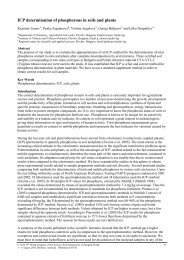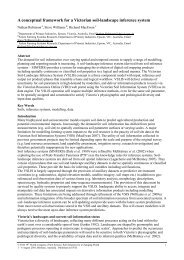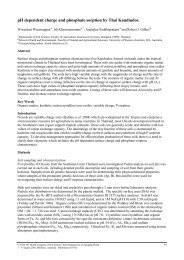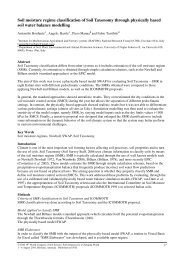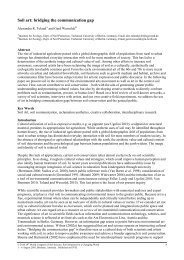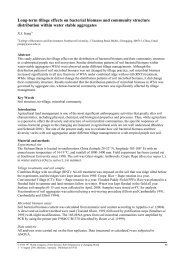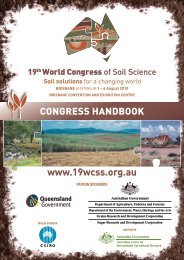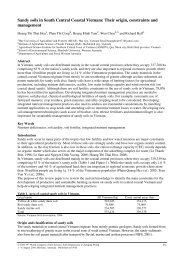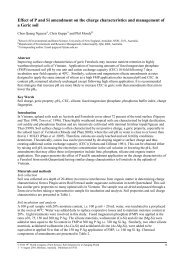Gilichinsky David - International Union of Soil Sciences
Gilichinsky David - International Union of Soil Sciences
Gilichinsky David - International Union of Soil Sciences
You also want an ePaper? Increase the reach of your titles
YUMPU automatically turns print PDFs into web optimized ePapers that Google loves.
<strong>Soil</strong>s <strong>of</strong> mid and low antarctic: diversity, geography, temperature regime<br />
<strong>David</strong> <strong>Gilichinsky</strong> A , Eugeny Abakumov B , Andrey Abramov A , Dmitri Fyodorov-Davydov A , Sergey<br />
Goryachkin C , Aleksei Lupachev A , Nikita Mergelov C and Elya Zazovskaya C<br />
A Institute for Physicochemical and Biological Problems <strong>of</strong> <strong>Soil</strong> Science, Russian Academy <strong>of</strong> <strong>Sciences</strong>, Puschino, Russia, Email<br />
gilichin@online.stack.net<br />
B St.-Petersburg State University, St.-Petersburg, Russia, Email e_abakumov@mail.ru<br />
C Institute <strong>of</strong> Geography, Russian Academy <strong>of</strong> <strong>Sciences</strong>, Moscow, Russia, Email sergey.gor@mail.ru<br />
Abstract<br />
The study <strong>of</strong> the Russian stations areas <strong>of</strong> Antarctica is very important in world soil geography as it is a kind<br />
<strong>of</strong> transit in soil-forming conditions between Dry Valleys from one side and Grearson Hills and Antarctic<br />
islands on the other one having been studied earlier by soil scientists from New Zealand, USA, Brazil and<br />
Germany. As for soil classification in the study areas Leptosols (Entisols) predominate but not Cryosols<br />
(Gelisols). The thawing depth <strong>of</strong> soils is more than the thickness <strong>of</strong> loose materials, cryoturbations are not<br />
well pronounced, and the thawing depth in sandy and stony materials here is <strong>of</strong>ten more than 1 m. So,<br />
Nudilithic Leptosols or Lithic Cryorthents predominate among soils. All the regions <strong>of</strong> the Russian Antarctic<br />
stations may be referred to two soil geographical divisions - Low-Antarctic humid barrens (Bellingshausen<br />
stations at King George Island) and Mid-Antarctic semihumid transitional zone between Cold deserts and<br />
humid Antarctic barrens (Novolazarevskaya, Molodezhnaya, Progress, Mirnyi, Leningradskaya, Russkaya<br />
stations on the continent).<br />
Key Words<br />
<strong>Soil</strong>s, Antarctic, diversity, genesis, geography, temperature regime.<br />
Introduction<br />
Nowadays, the majority <strong>of</strong> Antarctic soil investigations are taking place in West Antarctic – mostly in Dry<br />
Valleys, McMurdo Sound and King George Island (Bockheim 2002; Bockheim and Balks 2008; Campbell<br />
and Claridge 1987). Much less is known for Mid Antarctic <strong>of</strong> the East Antarctic: the northernmost Grearson<br />
Hills were studied for their soils (Beyer and Boelter 2007) as well as Bunger Hills (Glazovskaya 1958) and a<br />
part <strong>of</strong> Enderby Land (MacNamara 1969). The study <strong>of</strong> the Russian station areas in Antarctic is very<br />
important in world soil geography as it is a kind <strong>of</strong> transit in soil-forming conditions between Dry Valleys<br />
from one side and Grearson Hills and Antarctic islands from another one.<br />
Figure 1. Antarctic map by Antarctic Digital Database with points <strong>of</strong> soil investigations.<br />
© 2010 19 th World Congress <strong>of</strong> <strong>Soil</strong> Science, <strong>Soil</strong> Solutions for a Changing World<br />
1 – 6 August 2010, Brisbane, Australia. Published on DVD.<br />
32
Objects and methods<br />
The soil study <strong>of</strong> all coastal Russian Antarctic stations Novolazarevskaya (coordinates 70°46'S, 11°50'E),<br />
Molodezhnaya (67°40'S, 45°23'E), Progress (69°23'S, 76°23'E), Mirny (66°33'S, 93°01'E), Leningradskaya<br />
(69°30'S, 159°23'E), Russkaya (74°46'S, 136°52'W) and the station Bellingshausen (62°12'S, 58°56'W) on<br />
the King George Island, as well as <strong>of</strong> Hudson mountains (74 o 33'S, 99 o 09'W), Lindsey Island (73 o 76'S,<br />
102 o 00'W) were carried out (Figure 1). The field soil description and the microscopic analysis were fulfilled.<br />
<strong>Soil</strong> organic matter (SOM) analysis was done according to Ponomareva and Plotnikova method for humic<br />
(ha) and fulvic acids (fa) extraction and C and N contents were determined by wet combustion (Tyurin and<br />
Kjeldahl methods respectively). Microbial biomass was measured by fumigation method (Jenkinson 1998)<br />
and metabolic quotient was calculated as basal respiration/microbial biomass ratio (Method <strong>of</strong> <strong>Soil</strong> Analysis<br />
1994). Ground temperatures were measured by U12 HOBO loggers (Onset corp).<br />
Results<br />
<strong>Soil</strong> diversity.<br />
The following groups <strong>of</strong> soils were distinguished.<br />
1) Organo-mineral soils with macro-pr<strong>of</strong>iles (induced by input <strong>of</strong> organic material from the ocean –<br />
«ornithogenic» и «post-ornithogenic») – the active interaction <strong>of</strong> guano with soil minerals takes place here.<br />
Humus content was maximal in soils <strong>of</strong> penguin beaches, but the level <strong>of</strong> microbiological activity here was<br />
the lowest. Microbiological transformation <strong>of</strong> organic matter appeared to be more intensive in soils with<br />
decayed and leached guano. Intensive processes <strong>of</strong> weathering start in these post-ornithogenic soils. <strong>Soil</strong>s<br />
under the plants residues are characterized by prevailing <strong>of</strong> fulvic acids over the humic acids. The average<br />
Cha/Cfa ratio is 0,5. It was less in Hudson mountains and maximum in some sub-Antarctic soils. <strong>Soil</strong>s <strong>of</strong><br />
littoral organic material accumulation shows the higher amount <strong>of</strong> raw organic matter in organic horizons.<br />
Here humus is not associated with soil mineral part. These two soil types – under guano and littoral algae<br />
layers are typical for sea-shore territories. Meanwhile, some soils under penguin guano forms even in<br />
continental parts, situated at 4-5 km from seashore.<br />
2) Organo-mineral soils with micro-pr<strong>of</strong>iles (first centimeters depth) within fine-earth material under<br />
mosses, lichens and algae. <strong>Soil</strong>s <strong>of</strong> continental Antarctica contain about 0.3-1.0% <strong>of</strong> organic carbon or less,<br />
while in some sub-Antarctic soils this parameter rises up to 3% (table 1). The content <strong>of</strong> carbon that can be<br />
potentially mineralized was higher in sub-Antarctic soils and in all ornithogenic soils. It is explained by high<br />
amount <strong>of</strong> fresh organic matter and climatic specificity <strong>of</strong> the landscapes. Humus <strong>of</strong> continental soils was<br />
more stable to mineralization than maritime soils’ organic matter. SOM from King George Island was more<br />
enriched by nitrogen in comparison to SOM <strong>of</strong> continental soils. Microbial biomass was on the same level in<br />
all continental soils, but in some soils <strong>of</strong> King George Island it was essentially higher than in continental<br />
ones. Metabolic activity was essentially higher in all soil <strong>of</strong> sub-Antarctic which very good corresponds with<br />
the mineralization losses <strong>of</strong> SOM. Micromorphological study shows the higher degree <strong>of</strong> plant residues<br />
decaying and humification in sub-Antarctic soils than in continental ones by the climatic reasons. Period <strong>of</strong><br />
biological activity is about 60 days in sub-Antarctic, while it is not more than 15 days in continental<br />
Russkaya station.<br />
Table 1. <strong>Soil</strong> organic matter characteristics for upper horizons.<br />
С total, % C/N Сha Cha/Ctotal, % Microbial biomass, µg/g Metabolic quotient<br />
Сfa<br />
Russkaya station<br />
0,27 15,8 0,39 9.3 490 0.01<br />
Leningradskaya station<br />
0,48-1,02 14,0-19,9 0,33 6.9-8.2 310 0.06<br />
Hudson mountains<br />
0,42-0,67 49,1 -78,4 0,12 5.0-6.0 300 0.01<br />
Bellingshausen station (King-George)<br />
0,61-3,00 6,5-12,2 0,17-0,73 3-7.3 310-740 0.09-0.26<br />
3) Ahumic soils (by J.Tedrow) - soils with anisotropic pr<strong>of</strong>iles on fine earth materials without macroscopic<br />
life; the anisotropy is formed by abiogenic processes (cryogenic structure formation and blow-out <strong>of</strong> the fine<br />
earth from upper horizons). Such soils occupy large areas in continental part. These soils show strong<br />
weathering process which expressed in salts accumulation in whole pr<strong>of</strong>ile and formation <strong>of</strong> salts crusts,<br />
which good correspond with data, obtained previously (Bockheim and McLeod 2006).<br />
© 2010 19 th World Congress <strong>of</strong> <strong>Soil</strong> Science, <strong>Soil</strong> Solutions for a Changing World<br />
1 – 6 August 2010, Brisbane, Australia. Published on DVD.<br />
33
4) Endolithic soils - the results <strong>of</strong> the pedogenesis here is intra-fissure fine earth and newly formed minerals<br />
<strong>of</strong> iron (hydr)oxides bringing to both intra-fissure space and rock surface the brown and red colors (Figure 2).<br />
They are the most widely spread soils in Antarctic. The life in continental Antarctic save itself in stones as<br />
the fine earth is not reliable due to strong winds (Friedmann and Ocampo 1976). The great amplitude <strong>of</strong> rock<br />
temperature results in numerous small fissures in granites and gneiss which are colonized by autotrophic<br />
algae under transparent minerals, e.g. quartz. The role <strong>of</strong> these organisms in transformation <strong>of</strong> minerals is<br />
very important. In these small fissures the processes <strong>of</strong> iron-containing silicates weathering, releasing <strong>of</strong><br />
ferrous forms from mineral lattice and their oxidation take place. Due to these processes surface and<br />
intrafissual films <strong>of</strong> brown (7.5YR) and even red (up to 10R) colors form on the rocks having initial Munsell<br />
hue <strong>of</strong> 5Y and 2.5Y. Besides that in stone blocks the etching <strong>of</strong> feldspars and quartz also takes place as well<br />
as the formation <strong>of</strong> fine sand and silt material (Figure 2).<br />
<strong>Soil</strong> classification<br />
As for soil classification in the study areas Leptosols (Entisols) predominate but not Cryosols (Gelisols). The<br />
thawing depth <strong>of</strong> soils is <strong>of</strong>ten more than the shallow depth <strong>of</strong> loose materials, cryoturbations are not well<br />
pronounced, and the thawing depth in sandy and stony materials here is <strong>of</strong>ten more than 1 m, especially on<br />
the northernmost stations (Figure 3). So, Nudilithic Leptosols or Lithic Cryortents predominate among soils.<br />
The strong transformation <strong>of</strong> iron (hydr)oxides in Antarctic soils to be taken into account for soil<br />
classification needs the widening <strong>of</strong> the WRB criteria for Chromic prefix, as now it is only fit for loose<br />
subsurface horizons. Some films on the stone surfaces are characterized by a high content <strong>of</strong> iron (up to<br />
15%) and aluminum (up to 10%). The Si/Fe+Al ratio here is about 2-3 which is a result <strong>of</strong> amorphous iron<br />
and aluminum accumulation in films. At the same time the surfaces <strong>of</strong> stones could be enriched by organic<br />
matter, locally concentrated here due to the activity <strong>of</strong> epilitic communities <strong>of</strong> fungi, algae and lichens. <strong>Soil</strong>s<br />
<strong>of</strong> King George Island were classified as ornithosols (Leptosols Ornitic), Lithic Leptosols and Haplic<br />
Leptosols. <strong>Soil</strong>s in a very windy and cold valley near the Russkaya station besides Cryosols were represented<br />
by Lithic Leptosols, while soils <strong>of</strong> Leningradskaya station and in Hudson mountains were Haplic Leptosols<br />
and Lithic Leptsols. Lindsey Island was covered by actual ornithosols and post-ornithogenic soils.<br />
A<br />
B<br />
C<br />
D<br />
Figure 2. Microphotographs <strong>of</strong> endolithic soils near Molodeznaya station: A – fresh enderbite (granite with<br />
hornblende) rock surface; B – zone <strong>of</strong> weathering <strong>of</strong> Fe containing minerals and fine earth formation; C –<br />
reddish polished film on the rock surface; D – general view <strong>of</strong> endolithic soils.<br />
<strong>Soil</strong> geography<br />
All the regions <strong>of</strong> the Russian Antarctic stations may be referred to two soil geographical divisions – Low-<br />
Antarctic humid barrens (Bellingshausen stations, King George Island) and Mid-Antarctic semihumid<br />
transitional zone between Cold deserts and humid Antarctic barrens (Novolazarevskaya, Molodezhnaya,<br />
Progress, Mirny, Leningradskaya, Russkaya stations). There is some difference within the second division<br />
related to humidity. The southernmost stations (Novolazarevskaya, Russkaya) have more severe and arid<br />
conditions. <strong>Soil</strong>s <strong>of</strong> maritime Antarctica are acid, with low content <strong>of</strong> exchangeable bases, pr<strong>of</strong>iledifferentiated<br />
in chemical composition. These soils were formed on moraines, fluvioglacial sands and<br />
alluvium, while soils from continental Antarctica were formed on debris <strong>of</strong> massive crystalline rocks. Salts<br />
and iron films are revealed only in continental soils. Smectite dominates in clay fraction <strong>of</strong> all soils, but<br />
sometimes illite and kaolinite occur. Pr<strong>of</strong>ile distribution <strong>of</strong> mineral was strongly affected by stratigraphy <strong>of</strong><br />
© 2010 19 th World Congress <strong>of</strong> <strong>Soil</strong> Science, <strong>Soil</strong> Solutions for a Changing World<br />
1 – 6 August 2010, Brisbane, Australia. Published on DVD.<br />
34
parent materials. <strong>Soil</strong>s <strong>of</strong> Russkaya and Leningradskaya stations as well as soils <strong>of</strong> Hudson mountains do not<br />
show the process <strong>of</strong> secondary clay minerals formation. Here only mechanical crushing <strong>of</strong> minerals occurs<br />
with strongly expressed corrasion <strong>of</strong> the surface. The maximum intensity <strong>of</strong> weathering and formation <strong>of</strong><br />
secondary mineral was revealed in soils <strong>of</strong> King-George Island.<br />
Temperature regime<br />
The permafrost and soil mean annual temperature on King-George Island is close to zero (-0,25 o C). Such<br />
temperature indicates the north border <strong>of</strong> permafrost in Antarctic and the probability <strong>of</strong> permafrost<br />
degradation and disappearance <strong>of</strong> permafrost-affected soil in the case <strong>of</strong> warming.<br />
Figure 3. <strong>Soil</strong> temperature regime during the year on Molodezhnaya (latitude is 67°40'S) (A), Bellingshausen<br />
(62°12'S) (B) and Russkaya (74°46'S) (C) stations.<br />
Conclusion<br />
This study shows the diversity <strong>of</strong> soils in previously unexplored regions <strong>of</strong> Eastern and Western Antarctic<br />
most <strong>of</strong> which can be attributed to Mid-Antarctic semihumid transitional zone between Cold deserts and<br />
humid Antarctic barrens. Both Nudilithic Leptosols and Cryosols predominate in ice-free oases, and areas <strong>of</strong><br />
Leptosols are even larger. The endolithic soils formed by interactions <strong>of</strong> cryptoendolithic algae and lichens<br />
with minerals in cryogenic superficial cracks <strong>of</strong> solid rocks are widespread in oases. The depth <strong>of</strong> active<br />
layer on the continent is close to or even more than 1 m because <strong>of</strong> coarse texture <strong>of</strong> substrates and thin, if<br />
any, organic horizon. King-George Island is on the north border <strong>of</strong> permafrost in Antarctic. The gained data<br />
give the additional material for the <strong>Soil</strong> Data Base <strong>of</strong> Antarctic, which is being created now in the context <strong>of</strong><br />
ANTPAS program.<br />
References<br />
Beyer L, Boelter M (2002) ‘Geoecology <strong>of</strong> Antarctic Ice-Free Coastal Landscapes’. (Springer-Verlag Berlin:<br />
Heidelberg).<br />
Bockheim JG (2002) Landform and soil development in the McMurdo Dry Valleys: a regional synthesis.<br />
Arctic, Antarctic and Alpine Res. 34, 308-317.<br />
Bockheim JG, McLeod M (2006) <strong>Soil</strong> formation in Wright Valley, Antarctica since the late Neogene.<br />
Geoderma 137, 109-116.<br />
Bockheim JG, Balks M (2008) Antarctic soils and soil forming processes in a changing environment.<br />
Geoderma 144, 1-414.<br />
Campbell IB, Claridge GGC (1987) ‘Antarctica: <strong>Soil</strong>s, Weathering Processes and Environment’. (Elsevier:<br />
Amsterdam).<br />
Friedmann EI, Ocampo R (1976) Endolithic blue-green algae in dry valleys: primary producers in Antarctic<br />
desert ecosystem. Science 193, 1247-1249.<br />
Glazovskaya MA (1958) Vyvetrivanie i pervichnoe pochvoobrazovanie v Antarktide (Weathering and<br />
primary soil formation in Antarctica) Nauch. Dok. Vish. Shkol., Geol. Geog. Nauki 1, 63-76.<br />
Jenkinson DS (1998) The determination <strong>of</strong> microbial biomass carbon and nitrogen in soil. In ‘Advances in<br />
Nitrogen Cycling in Agricultural Ecosystems’. pp. 368-386. (CAB <strong>International</strong>: Walingford)..<br />
MacNamara EE (1969) Pedology <strong>of</strong> Enderby Land, Antarctica. Antarctic J. <strong>of</strong> the U.S. 4, 208-209.<br />
Methods <strong>of</strong> <strong>Soil</strong> Analysis (1994). In ‘Methods <strong>of</strong> soil analysis. Part 2. (American Society <strong>of</strong> Agronomy Inc.:<br />
Madison, WI).<br />
© 2010 19 th World Congress <strong>of</strong> <strong>Soil</strong> Science, <strong>Soil</strong> Solutions for a Changing World<br />
1 – 6 August 2010, Brisbane, Australia. Published on DVD.<br />
35



